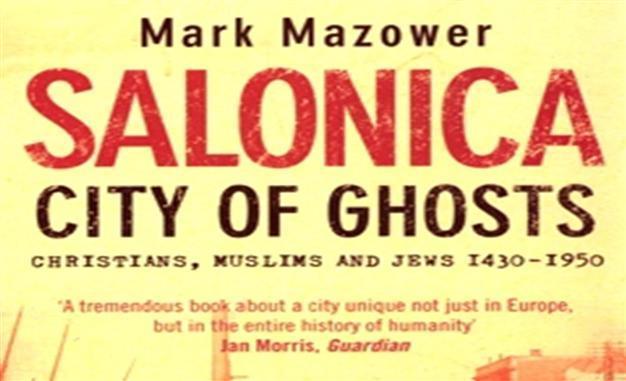Salonica: City of Ghosts
William Armstrong - william.armstrong@hdn.com.tr
 ‘Salonica: City of Ghosts – Christians, Muslims and Jews 1430-1950’ by Mark Mazower (Harper Perennial, 2004, 30TL, pp 525)
‘Salonica: City of Ghosts – Christians, Muslims and Jews 1430-1950’ by Mark Mazower (Harper Perennial, 2004, 30TL, pp 525)
In 1911 a local newspaper wrote of Salonica: “[It] is not one city. It is a juxtaposition of tiny villages … each of these groups which one today calls ‘Nations’ keeps well away from the others, as if fearing contagion.” While it may challenge the modern tendency to romanticize the Ottoman Empire’s religious diversity, this imperfect truth generally held across most of its lands for most of its history; for all the remarkable cultural tolerance, tensions were never far from the surface. Although alive to the many moments of genuine cross-confessional pollination in this excellent 500-year history of Salonica, Mark Mazower is equally careful not to neglect the more unsentimental truths. The method is well-suited to his subject, as there is unquestionably a dark and tragic arc to the city’s history.
The book opens with the Ottoman conquest of Salonica in 1430, which is effectively when the classic mingling of peoples began. At first it was only Greeks and Turks, but at the end of the fifteenth century the Iberian Jews also arrived in Ottoman territory after being expelled by the Spanish Inquisition. By far the most went to Salonica, where they went on to become the most populous religious community in an astonishingly short space of time (and a fine economic investment for their rulers). Thus developed a delicate confessional balance of power that was largely maintained for the next 500 years: “ruled by Muslims, dominated by Jews, in an overwhelmingly Christian hinterland.”
The nineteenth and twentieth centuries were extraordinarily tumultuous for Salonica, so it’s just as well that over two thirds of the book are devoted to them. The Greek War of Independence that erupted in 1821 was perhaps the first significant result of the force that would go on to rip the Ottoman Empire apart - nationalism. Although Salonica itself did not itself become part of the new Kingdom of Greece until 1912, those Greeks still within Ottoman territory would henceforth always feel the pull of divided loyalties. At around the same time, the modernizing and centralizing “Tanzimat” reforms were being initiated, but there was an irresolvable paradox: The reforms that aimed to keep the empire together came from the same modernizing impulse that was leading to the nationalism fraying away the empire’s edges.
Salonica went on to become the major center of the Committee of Union and Progress (Young Turks), which unseated Sultan Abdul Hamid II in 1908 and returned the empire to constitutional rule for the first time since 1876. Mazower stresses the initially multi-confessional character of the Young Turk revolution, which placed an “Ottomanist” emphasis on the values of cosmopolitan loyalty to the empire over the divisive power of nationalism. But unstoppable forces had already been unleashed; the optimistic window could not remain open for long, and by 1910 the unifying ideology of Ottomanism had more or less collapsed.
Salonica was soon taken by Greece, and was then engulfed by an enormous fire in 1917, symbolically destroying the essence of the Ottoman town and its core; out of the ashes emerged a new, purged Salonica. The effect was multiplied immeasurably by the enforced population exchanges between the Greek and Turkish states in the 1920s. The forcible uprooting of over a million people was conducted in the name of geopolitical stability and nation-building, but it was strikingly denounced by Archbishop Chrysostomos of İzmir at the time as the “counting and exchange of human beings – incomprehensible, unheard-of and unprecedented in the chronicles of History – as done by animal dealers with horses, livestock, and cattle.”
In 1913, Greeks had been a minority of Salonica’s population, but by 1928 they made up 75 percent of it. The vast majority of the rest were Jews, and the city’s history takes on an immeasurably darker hue with the German occupation of Greece in WWII. Mazower goes through the awful details of Jewish deportations from Salonica to extermination in Eastern Europe, which was assisted by the ignorance (often willful) and occasional relish of the city’s Christian population. In the end, one-fifth of the population was killed off; 500 years of history eliminated “in a matter of weeks.”
Considering the events that have shaped the city, “Salonica…” is inevitably a somber read, but it is also a deeply instructive one. Mazower has a formidable command over his sources and guides us through events with a calm, meticulous authority. What results is a superb achievement that cannot be recommended highly enough.
Recommended recent release
‘Asymmetry of Interest: Turkish-Iranian Relations since 1979’ by Elliot Hentov
LAP Lambert, $100, pp 312
William Armstrong -
william.armstrong@hdn.com.tr
 ‘Salonica: City of Ghosts – Christians, Muslims and Jews 1430-1950’ by Mark Mazower (Harper Perennial, 2004, 30TL, pp 525)
‘Salonica: City of Ghosts – Christians, Muslims and Jews 1430-1950’ by Mark Mazower (Harper Perennial, 2004, 30TL, pp 525)